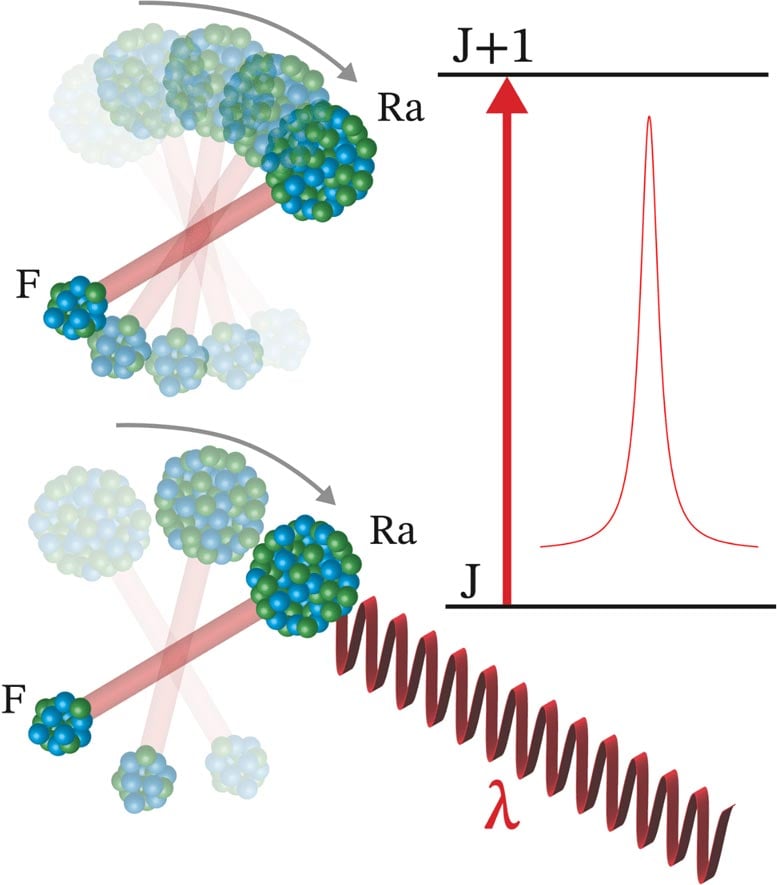By
Physicists have achieved a breakthrough by precisely measuring the properties of radium monofluoride, insights that could explain the matter-antimatter asymmetry of the universe—essentially why we exist. The research highlights how the molecule’s unique properties might be leveraged in future experiments to test theories that go beyond the Standard Model of particle physics. Credit: SciTechDaily.com
Researchers have successfully measured the quantum structure of radium monofluoride (RaF) using ion-trapping and specialized laser techniques, allowing for the detailed characterization of its rotational energy levels and establishing a laser-cooling scheme.
These findings are crucial for future experiments focused on laser-cooling and trapping RaF molecules, which are expected to play a significant role in studies of nuclear electroweak properties and violations of parity and time-reversal symmetry, potentially explaining the universe’s matter-antimatter asymmetry.
For the first time, nuclear physicists made precision measurements of a short-lived radioactive molecule, radium monofluoride (RaF). The researchers combined ion-trapping techniques with specialized laser systems to measure the fine details of the quantum structure of RaF. This allowed the characterization of the rotational energy levels of this molecule as well as the determination of its laser-cooling scheme. Laser cooling is a method that uses laser light to slow down and trap atoms and molecules. These results represent a pivotal step for future experiments aiming to laser-cool and trap RaF molecules.

Using lasers with precisely tuned frequency, λ, physicists control rotational states of radium monofluoride molecules and excite specific rotational levels, characterized by the quantum number, J. These excitations manifest as sharp spectral peaks. Credit: Silviu-Marian Udrescu
Insights Into Physics Beyond the Standard Model
Scientists predicted that molecules that contain heavy, pear-shaped nuclei, such as radium, are highly sensitive to nuclear electroweak properties and physics beyond the Standard Model. This includes phenomena that violate parity and time-reversal symmetry.
Time reversal-violation, beyond the current constraints, is an essential condition to explain the matter-antimatter asymmetry of the universe. The new results give researchers a detailed characterization of the quantum structure of RaF, opening the use of this molecule in future experiments aiming to search for such effects.
Spectroscopic Studies at CERN
Radioactive molecules containing octupole-deformed nuclei, such as radium (Ra), promise to be exceptional quantum systems for use in studies of the fundamental particles and forces of nature. The unique pear-like shape of the radium nucleus, combined with the energy level structure of a polar molecule, can lead to an enhanced sensitivity to symmetry-violating nuclear properties of more than five orders of magnitude compared to stable atoms.
Recently, nuclear physicists at the Massachusetts Institute of Technology (DOI: 10.1038/s41567-023-02296-w
This work was supported by the U.S. Department of Energy Office of Science, the Office of Nuclear Physics; the MISTI Global Seed Funds; Deutsche Forschungsgemeinschaft (DFG, German Research Foundation); Belgian Excellence of Science (EOS); KU Leuven C1 project; International Research Infrastructures (IRI) project; the European Unions Grant Agreement (ENSAR2); LISA: European Union’s H2020 Framework Programme; and the Swedish Research Council














/https://tf-cmsv2-smithsonianmag-media.s3.amazonaws.com/filer_public/34/31/3431771d-41e2-4f97-aed2-c5f1df5295da/gettyimages-1441066266_web.jpg)






Discussion about this post